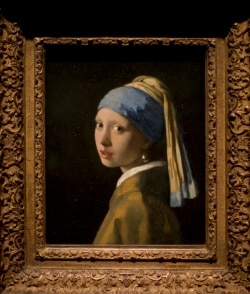Researchers have used high technology methods to learn secrets about a famous painting by the Dutch painter Johannes Vermeer.
The painting is called “Girl with a Pearl Earring.” Vermeer is considered one of the masters of his art. He worked during the Dutch Golden Age of painting in the sixteen hundreds.
The researchers’ tests have not discovered the identity of the mysterious woman in the painting. But, they have revealed important information about how Vermeer did the painting, which is sometimes called the Dutch “Mona Lisa.”
In an online presentation this week, Martine Gosselink, Director of the Mauritshuis museum in The Hague, described some recent research findings.
“Sadly we didn’t find out who this young lady was and if she ever really existed. But we did get a little closer to her,” she said.
Researchers and museum workers placed the painting in a special glass room in early 2018 so visitors to the museum could watch as researchers studied the work.
A careful examination of very small pieces of paint showed where some of the painting’s pigments came from.
The white that helps form the earring comes from lead from the Peak District in northern England.
The blue is made from a valuable stone found in Afghanistan.
The red is made from insects that live on cactus plants in Mexico and South America.
Abbie Vandivere was leader of the research project. She expressed surprise that Vermeer used so much blue in the painting, noting: “This blue pigment was more valuable than gold in the 17th century.”
Vermeer, however, did not have to travel the world to get his materials. He most likely bought them in his hometown of Delft.
The research findings do not just show details about Vermeer’s materials, “but also tell us about Dutch and world trade in the 17th century,” Vandivere said.
The research also uncovered the order in which Vermeer painted the girl on a piece of cloth.
Infrared imaging showed that Vermeer began making the work using brown and black paint. He then drew the girl’s outline in black lines before working from the green background to the foreground.
“The girl has, sadly, not revealed her identity, but we have got to know her better,” Gosselink said.
A statement on the museum’s website describes the woman as imaginary. The painting “is not a portrait, but a ‘tronie’ – a painting of an imaginary figure,” the website says.
But, the public will have to wait until they can see the painting in real life. The Mauritshuis is currently closed, along with all other Dutch museums and galleries,
These closures are because of restrictions aimed at slowing the spread of the new coronavirus.
I’m John Russell.
Mike Corder reported on this story for the Associated Press. John Russell adapted it for Learning English. Mario Ritter, Jr. was the editor.
________________________________________________________________
Words in This Story
presentation – n. an activity in which someone shows, describes, or explains something to a group of people
museum – n. a building in which interesting and valuable things (such as paintings and sculptures or scientific or historical objects) are collected and shown to the public
pigment – n. a substance that gives color to something else
infrared -- n. technical: producing or using rays of light that cannot be seen and that are longer than rays that produce red light
reveal -- v. to make (something) known; to show (something) plainly or clearly : to make (something that was hidden) able to be seen
imaginary – adj. not real : existing only in your mind or imagination
portait – n. a painting, drawing, or photograph of a person that usually only includes the person's head and shoulders
figure – n. a drawing or representation of a person
We want to hear from you. Write to us in the Comments Section.









